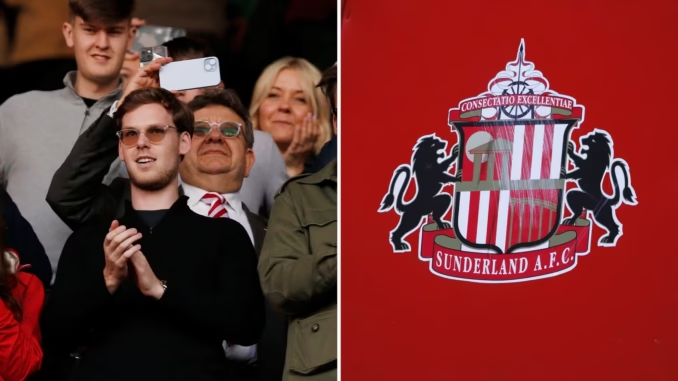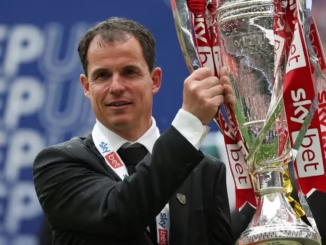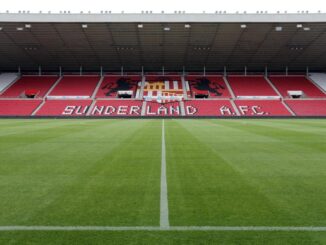
eams promoted to the Premier League are hampered by PSR rules which allow established clubs to spend more. Football finance guru Kieran Maguire assesses how this affects Sunderland and sees grounds for
Threat of financial calamity removed from Baggies
West Bromwich Albion had effectively been in decline ever since the club was sold to a Chinese consortium in August 2016, paying a figure north of £200m to buy former owner Jeremy Peace’s stake.
Controlling shareholder Guochuan Lai’s ownership was fairly disastrous for the club, but his unloved tenure finally came to an end after Bilkul Football WBA, a company ultimately owned by Florida-based entrepreneur Shilen Patel and his father Dr Kiran Patel, acquired an 87.8% shareholding in West Bromwich Albion Group Limited, the parent company of West Bromwich Albion Football Club.
This change in ownership was urgently required, due to the numerous financial problems facing West Brom, including growing high-interest debt and serious cash flow concerns, following years of no investment from the former owner.
Indeed, West Brom’s auditors had already rung the alarm bell in the 2021/22 accounts when they cast doubt on the club’s ability to continue as a going concern without making player sales, “Should the forecasted player trading not be achieved, the group would need to both maintain existing and find further sources of investment in order to bridge its cashflow position until appropriate player transactions are fulfilled.”
However, the good news is that there is no such comment in the latest 2022/23 books, thanks to the arrival of the new owners, as the club noted that a funding agreement has been agreed with the EFL to 30 June 2025.
Following the takeover, the new owners have repaid the £5m loan to Wisdom Smart Corporation Ltd, a Hong Kong based company controlled by Guochuan Lai, which was originally justified by Lai using the argument that his “international business suffered” during the COVID pandemic.
In 2022/23 West Brom swung from a £5.4m pre-tax profit to an £11.0m loss, as revenue dropped £8.7m (13%) from £65.4m to £56.7m, exacerbated by profit from player sales falling £10.4m from £16.9m to £6.5m, while operating expenses only reduced by £1.7m to £75.5m.
The main reason for Albion’s £8.7m revenue decrease was a reduction in parachute payments in the second season after relegation from the Premier League, which led to broadcasting falling £8.5m (16%) from £51.6m to £43.1m.
Indeed, the loss in 2023/24 is likely to be even higher, as they will no longer benefit from parachute payments with Patel indicating a “significant deficit”, as this was the club’s first season without Premier League monies in 22 years.
Like many other clubs, West Brom have become increasingly reliant on player sales, generating £67m profit in the last five years. During this period, they have made more than £10m on three occasions, including £29m in 2019/20, mainly thanks to Salomon Rondon to Chinese club Dalian and Jay Rodriguez to Burnley.
However, last season’s figure will be very low, as the only sale for decent money was Taylor Gardner-Hickman to Bristol City. Accelerating the O’Shea sale helped the 2022/23 accounts, but had the opposite effect on the following season’s figures. It will be interesting to see whether Albion try to balance the books by making money from player sales this summer or decide to hang on to their talent to boost their chances of promotion.
Despite the reduction in revenue, West Brom’s wage bill actually rose £3.5m (8%) from £42.4m to £45.9m, as the club decided to retain as strong a squad as possible. The increase was also driven by additional new first-team players and the replacement of Steve Bruce and his coaching staff. This means that wages have basically halved since the £92m all-time high five years ago in the Premier League.
In 2022/23 Albion’s £46m wage bill was the fifth highest in the Championship, only below four other clubs with parachute payments: Norwich City £56m, Burnley £54m, Watford £49m and Sheffield United £48m. However, the wage bill is likely to have been much lower last season after the departure of a few players on free transfers and loans, even if those deals did not generate much money in terms of player sales. West Brom were fifth highest in both wages and revenue in 2022/23, which was also where they finished in the league the following season.
Lai and his colleagues did not provide any funding to the club for ages, either because they were unwilling or unable to do so. In fact, in the last five years there was actually an outflow of £5m. Many clubs’ owners have provided substantially more funding than Albion’s, as the Championship is a division that has an endless appetite for shareholder support. For example, in the same 5-year period, nine clubs received more than £50m, albeit with varying degrees of success, led by Reading and Bristol City.
As parachute payments have ended, life has become more difficult for West Brom in the Championship. Their £11m loss in 2022/23 was not out of the ordinary for this division, though things are likely to get worse before they get better financially.
That said, the change in ownership does deliver some hope for the future, bringing Guochuan Lai’s miserable tenure to an end. This should have removed the threat of financial calamity, but it will still be tricky to find the right balance between sustainability and having a competitive squad, especially as several players are out of contract this summer.
This famous old club at last appears to have committed ownership, which will be important as Albion strive for promotion. Patel emphasised the new sense of togetherness, “For the first time in a long time, there is an opportunity for us all to be together as we embark on a new season, pushing as one for the collective good of the football club.”
However, it will really help if Albion manage to hang on to Corberan, who has made a significant difference since his arrival, even though his success has surely attracted the attention of a number of suitors.
Fulham requires big funding from owner
After lengthy delays, Fulham’s shiny, new Riverside Stand has finally opened, creating “a unique Thameside destination with first class facilities for supporters and partners on match days, as well as for the wider community year-round”.
This ambitious project has increased Craven Cottage’s capacity by around 4,000 to 29,600, while it has also taken advantage of the club’s fantastic location and wealthy catchment area by including two Michelin star restaurants, a rooftop swimming pool, corporate hospitality and event space, all benefiting from views of the Thames.
Chief executive Alistair Mackintosh observed, “Fulham is the sort of club that can have a business class or first class and have fans that turn left on a plane.”
Indeed, there is also an exclusive members club – with a football season ticket as an optional extra. It’s fair to say that “the times they are a-changing”, as this is a long way from the traditional pie and a pint.
However, in a world where clubs face the twin challenges of competing with wealthier rivals and complying with Profitability and Sustainability Regulations (PSR), this development does make sense – even though the payback on a substantial investment costing an estimated £350m will take a considerable time.
A review of Fulham’s finances helps explain why the Riverside development is so important to the club’s business model, using the most recent accounts. These are from the 2023/24 season, when they finished 13th in the Premier League, while also reaching the semi-finals of the Carabao Cup, before losing to eventual winners Liverpool.
Fulham’s pre-tax loss widened from £26m to £33m, despite profit on player sales rising from £9m to £33m. Revenue “remained consistent” at £182m, but there was a sharp increase in operating expenses, which shot up £34m (15%) from £217m to £251m.
There was good growth in both commercial, which rose £6m (26%) from £23m to £29m, and gate receipts, up £3m (21%) from £15m to £18m. However, this was offset by a £9m (7%) reduction in broadcasting from £144m to £135m, due to finishing three places lower in the Premier League.
Player sales
Up until last season, Fulham had not made much money from player sales, generating a profit of just £21m in the three years before then. Furthermore, they have only exceeded a £20m gain on three occasions.
Fulham made £33m from player sales, which is a new club record, mainly thanks to the big money sale of Aleksander Mitrovic to Saudi club Al-Hilal. Even after significantly increasing the profit compared to the previous season, this was still towards the lower end of the Premier League. Nine clubs made more than twice as much, with four of them generating more than £100m, namely Chelsea £152m, Manchester City £139m, Brighton £110m and Nottingham Forest £101m.
This season will also be decent, following the sales of Joao Palhinha to Bayern Munich and Jay Stansfield to Birmingham City, with the club advising that it has made £43m profit from player sales.
Losses are nothing new for Fulham, as the last time they made a profit was way back in 2010/11. Since Shahid Khan bought the club in July 2013, they have posted £417m of losses, averaging £38m a year.
The club has been hindered by its policy of buying older players with Premier League experience, which helps its prospects in the short-term, but is not conducive to large player trading profits.
Long term losses
Losses are nothing new for Fulham, as the last time they made a profit was way back in 2010/11. Since Shahid Khan bought the club in July 2013, they have posted £417m of losses, averaging £38m a year. This includes more than quarter of a billion Pounds in the last five years alone, when the owner twice absorbed huge losses in a bid to return to the Premier League as soon as possible, then continued to lose money in a bid to survive in the top flight.
Fulham’s £257m loss in the last five years is one of the highest in England, with only five clubs in the Premier League having a worse performance, though some lost a lot more, especially Everton £442m and Manchester United £358m. Only four Premier League clubs have made a higher operating loss than Fulham’s £337m in the last five years, though their West London neighbours Chelsea lost a staggering £926m.
Broadcasting is by far the most important revenue stream, accounting for 74% of total income, followed by commercial 16% and match day 10%. Fulham’s £182m revenue is still firmly in the bottom half of the top flight at 14th highest, sandwiched between Everton £187m and Wolves £178m. For some more perspective, they were miles below the Big Six, four of whom generated more than three times as much as the Cottagers: Manchester City £715m, Manchester United £662m, Liverpool £614m and Arsenal £614m.
Even though they might be no great shakes in the Premier League, Fulham were 28th in the Deloitte Money League, which ranks clubs globally by revenue, i.e. not far behind a famous old club like Benfica.
Despite last season’s increase, Fulham’s 24,311 attendance remains one of the smallest in the top flight, only higher than four clubs, namely Burnley 21,153, Brentford 17,082, Luton Town 11,276 and Bournemouth 11,108.
Fulham have said that the new Riverside stand will create important new revenue streams, but they have not quantified how much they expect this to deliver.
Ticket prices have attracted a lot of attention at Fulham in the past few years. These were frozen in 2021/22, but there have been rises every season since then, including a couple of significant increases: 10% after promotion in 2022/23, followed by an even bigger 18% in 2023/24.
The prices in the new Riverside Stand are even more striking, as the cheapest is £1,250, while the club has also introduced a new Platinum level at £3,000, which is the most expensive seat in the Premier League outside corporate hospitality.
Fulham’s wage bill rose £16m (11%) from £139m to £155m, which was another club record. In fact, their wages have significantly increased by £65m (71%) since promotion from the Championship two years ago. Fulham’s £155m wage bill was the 12th highest in the top flight, just behind Everton’s £157m. Fulham’s 85% wages to turnover ratio was actually the second worst ratio in the Premier League.
Fulham’s other expenses rose £5m (18%) from £31m to £36m, so these have more than doubled in the two years since promotion. The costs of operating in the Premier League are invariably higher than the Championship, but all clubs have been adversely impacted by the impact of high inflation on services and utilities.
This was yet another all-time high for Fulham, but still on the low side in the top flight, miles below the likes of Manchester City £190m, Liverpool £167m and Tottenham £159m. This cost category is likely to further increase as a result of the new facilities offered in the Riverside Stand (which will also be the case for depreciation).
Transfer spending
Fulham spent £88m on player purchases, mainly on Alex Iwobi from Everton, Calvin Bassey from Ajax, Timothy Castagne from Leicester City and Raul Jimenez from Wolves. In addition, Adama Traore arrived from Wolves on a free transfer, while Armando Broja was signed on loan from Chelsea. Although this was the club’s second highest ever outlay, it was still pretty low for the Premier League, with six clubs spending more than £200m, led by Chelsea £553m, Tottenham £272m and Arsenal £256m.
Fulham have been fairly consistent in their player purchases in the last two seasons, averaging £87m. This means that they have spent £302m on player purchases in the last five years, which is around 50% more than the £206m outlay in the preceding 5-year period (including £120m in 2018/19 alone9, so they have really ramped up their activity in the transfer market.
Even though Fulham have increased their spending, this is still nowhere near the big boys. Looking at player purchases for the last five years, Fulham only spent more than five other Premier League clubs, namely Crystal Palace, Burnley, Brentford, Sheffield United and Luton Town.
Debt, interest payments and funding
Fulham’s gross debt significantly increased from just £1m to £125m, as this was the first time in seven years that Shahid Khan did not convert his loans into equity, though £75m was converted after these accounts closed.
An incredible £907m of debt has been “written-off” in this way since 2012: £695m by Khan plus another £212m by former owner Mohamed Al Fayed. Otherwise, Fulham’s debt would be absolutely enormous.
Immediately after these accounts Fulham took out a £125m loan facility with JP Morgan Chase in relation to the completion of the Riverside Stand, repayable within five years. Interest is charged at SONIA plus 3.625%, so currently around 7.7%.
To date, thanks to the regular debt conversion, Fulham have paid hardly any interest on their loans, e.g. only £0.3m in 2023/24, while others have had to shell out much higher sums, especially Everton £44m, Manchester United £36m and Tottenham £29m.
Looking at the holding company, Cougar Holdco London Limited, Khan has provided Fulham with an incredible £863m of funding, all of which has been converted to equity, including £530m in the last five years alone.
This works out to an average of £78m a year since he bought the club in 2014, so he has essentially signed a cheque for around £1.5m a week ever since his arrival at Craven Cottage, which is a great deal of money by anyone’s standards.
In fact, in the last five years, Khan’s £530m funding was the second highest of any owner in the Premier League, only surpassed by Chelsea. However, that was more than all the other aspirational clubs, including Aston Villa, Everton and Newcastle United.
The club is fortunate that its owner Shahid Khan continues to provide significant financial support. The likelihood is that this funding is going to be required for some time yet.
After yesterday’s win Fulham still have a chance of playing in Europe again so good luck to them. If I win a decent prize on the Premium Bonds, I might treat myself and my partner to hospitality in the Riverside Stand!
For the latest news and breaking news, visit sportzonenews


Be the first to comment